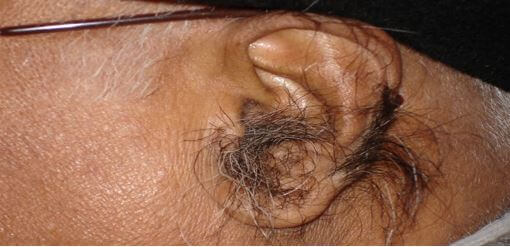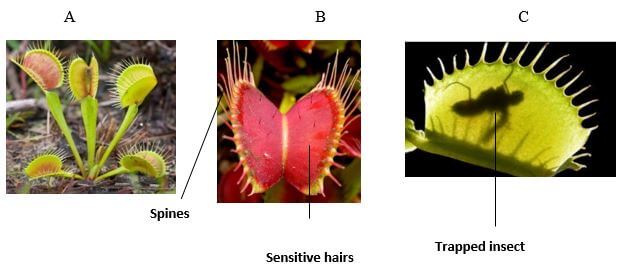INSTRUCTIONS
- Answer all the questions

QUESTIONS
-
- state the function of the following parts of hind brain
- Cerebellum (1mk)
- Medulla oblongata (1mk)
- state the function of the following parts of hind brain
- A person was found to pass out large volumes of dilute urine frequently Name the;
- Disease the person was suffering from (1mk)
- Hormone that was deficient (1mk)
- The diagram below shows a type of a nerve cell Study and answer the questions that follow

-
- Identify the type of nerve cell shown above 1mk
- Give a reason for your answer in a (i) above 1mk
- Name parts labeled Q and G 2mks
-
- Name the other types of nerve cells 2mks
- On the diagram using an arrow indicate the direction of the nerve impulse 1mk
-
- The equation below shows an oxidation reaction of Food substances
C51H98O6 + 145O2 ------- X CO2 + 98 H2O + energy- What do you understand by the term respiratory quotient? (2mark)
- Determine respiratory quotient of the oxidation of food substance (2marks)
- Identify the food substances (1mark)
-
- Study the photograph below showing a certain trait in man

- Identify the trait exhibited in the photograph above (1 mark)
- The trait you have identified in (d) (i) above is sex linked In which chromosome is it contained (1 mark)
- Name any other sex linked trait in man (1 mark)
- The man in the photograph married a woman Use a genetic cross to predict the offspring of the above marriage Let YH represent the gene for the trait above (4 marks)
- Study the photograph below showing a certain trait in man
- Below are photographs of Venus flytrap (an insectivorous plant) Study them and answer the questions that follow

- Name one major nutrient that is deficient in the soil where the above plant grows (1mk)
- Name the type of response shown by plate C (1mk)
- Describe how the above plant traps the insect (5mks)
-
- Explain the various types of tropism in plants 10mks
- Discuss the various kinds of evidence for evolution 10mks


MARKING SCHEME
-
- state the function of the following parts of hind brain
- Cerebellum (1mk)
- responsible for coordinating impulses, posture and balance, motor coordination and muscle tone
- Medulla oblongata (1mk)
- controls involuntary body activities i.e. heartbeat, blood pressure breathing rate, coughing and sneezing
- Cerebellum (1mk)
- state the function of the following parts of hind brain
- A person was found to pass out large volumes of dilute urine frequently Name the;
- Disease the person was suffering from (1mk)
- diabetes inspidus
- Hormone that was deficient (1mk)
- ADH
- Disease the person was suffering from (1mk)
- The diagram below shows a type of a nerve cell Study and answer the questions that follow

-
- Identify the type of nerve cell shown above 1mk
- Sensory neurone
- Give a reason for your answer in a (i) above 1mk
- Unipolar
- Identify the type of nerve cell shown above 1mk
- Name parts labeled Q and G 2mks
- Q-cell body
- G-myelin sheath
-
- Name the other types of nerve cells 2mks
- Motor neurone
- Relay neurone
- On the diagram using an arrow indicate the direction of the nerve impulse 1mk
- Name the other types of nerve cells 2mks
-
- The equation below shows an oxidation reaction of Food substances
C51H98O6 + 145O2 ------- X CO2 + 98 H2O + energy- What do you understand by the term respiratory quotient? (2mark)
-
- Determine respiratory quotient of the oxidation of food substance (2marks)
- RQ= 0.7
- Identify the food substances (1mark)
-
Lipids
-
- What do you understand by the term respiratory quotient? (2mark)
-
- Study the photograph below showing a certain trait in man

- Identify the trait exhibited in the photograph above (1 mark)
- Hairy pinna
- The trait you have identified in (d) (i) above is sex linked In which chromosome is it contained (1 mark)
- Y -chromosome
- Name any other sex linked trait in man (1 mark)
- Premature baldness
- Colourblindness
- Haemophilia
- The man in the photograph married a woman Use a genetic cross to predict the offspring of the above marriage Let YH represent the gene for the trait above (4 marks)
- Identify the trait exhibited in the photograph above (1 mark)
- Study the photograph below showing a certain trait in man
- Below are photographs of Venus flytrap (an insectivorous plant) Study them and answer the questions that follow

- Name one major nutrient that is deficient in the soil where the above plant grows (1mk)
- Nitrogen
- Name the type of response shown by plate C (1mk)
- Haptonasty
- Describe how the above plant traps the insect (5mks)
-
When the sensitive hairs are touched by a landing insect, the mid-rib cells lose water rapidly losing their turgor. This causes the trap to spring inwards hence closing the leaf with spines interlocking.
-
- Name one major nutrient that is deficient in the soil where the above plant grows (1mk)
-
- Explain the various types of tropism in plants 10mks
- Phototropism
growth movements of plant shoots in response to unilateral sources of light the tip of the shoots produce auxins down the shoot light causes auxins to migrate to outer side/darker side causing growth on the side away from light hence growth curvature towards source of light roots are negatively phototrophic - Geotropism
response of roots/parts of a plant to the direction of force of gravityauxins grow towards the direction of force of gravity causing positive geotropism in roots while shoot grows away from force of gravity (negatively geotrophic) - Thigmotropism/Haptotropism
growth response of plant when in contact with an object contact with support causes migration of auxins to outer side causing faster growth on the side away from contact surface this causes tendrils/stem to twin around a support - Hydrotropism
growth movement of roots in response to unilateral source of water/moisture the root grows towards the source of water/ positively hydrotropic while leaves are negatively hydrotropic - Chemotropism
growth movement of parts of plant to unilateral source of chemicals the chemicals form a gradient between two regions e.g. pollen tube growing towards the ovary through the style
- Phototropism
- Discuss the various kinds of evidence for evolution 10mks
- Fossils
fossils are remains of organisms preserved in naturally occurring materials for many years
they give evidence of types of plants/animals that existed at certain geological age/long ago/millions of years ago
gives evidence of morphological/anatomical/structural changes that have taken place over a long period of time e.g. human skull, leg of horse - Comparative anatomy
gives evidence of relationship among organisms/gives evidence of a common ancestry of a group of organisms
organisms have similar structures/organs performing the same function e.g. digestive system/ urinary system/nervous system/vestigial structures and vertebrate heart- Divergence
where the basic structural form is modified to serve different functions e.g. vertebrate forelimb/beak structure in birds/birds feet/parts of a flower. These are called homologous structures
homologous structures have a common embryonic origin but are modified to perform different functions e.g. the pentadactyl limb - adaptive radiation
is a situation where organism have a homologous structure with common embryonic origin which is modified to perform different functions to adapt organisms to different ecological niches/habitats e.g. beaks of Darwinian finches(birds) - Convergence
is where different structures are modified to perform a similar function e.g. wings of birds and insects/eyes of humans and octopuses. These are called analogous structures - Vestigial structures
are greatly reduced in size and have ceased to function e.g. human appendix/caecium/coccyx in humans, wings of kiwi (flightless bird), presence of hind limb pad in python, halters in insects, human hair nictitating membrane in human eye, human ear muscle, pelvic girdle in whale and third digit of wing of bird.
- Divergence
- Comparative embryology
some embryos of different animals appear very similar thus showing relationship and possibility of a common ancestry
different classes of vertebrates larvae of Annelida and Mollusca are similar (tocophere) - Comparative serology/physiology
these show biochemical and immunological comparisons of blood groups/components to show immunological similarities of tissues therefore showing relatedness of different organisms
e.g. antigen antibody reactions, human blood groups/Rh factor reveal some phylogenic relationship among organisms/common ancestry - Geographical distribution
organisms differ in various geographical regions
present continents are thought to have been a large land mass joined together/pangea/Eurasia/Gondwanaland
present continents drifted apart from one land mass/continental drift
as a result of continental drift isolation of organisms occurred bring about different patterns of evolution
organisms in each continent evolved along different lines hence emergence of new species/divergence/convergence
Examples
--llama, jaguar, panther in S. America - Cell biology (cytology)
structures and functioning of cells are similar
occurrence of organelles e.g. mitochondria in all cells/both plant and animal cells
these point at a common ancestry
- Fossils
- Explain the various types of tropism in plants 10mks
Download Biology Questions and Answers - Form 4 Mid Term 2 Exams 2023.
Tap Here to Download for 50/-
Get on WhatsApp for 50/-
Why download?
- ✔ To read offline at any time.
- ✔ To Print at your convenience
- ✔ Share Easily with Friends / Students

